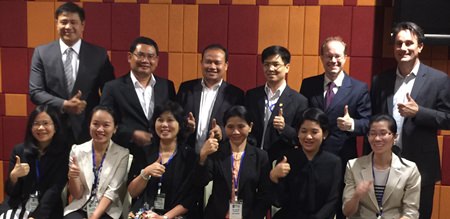Bangkok, 2 March 2015 – Advanced preparation of a new tourism marketing strategy and action plan for the Greater Mekong Subregion (GMS) was announced on 27 February at a workshop supported by the Asian Development Bank and the Thailand Ministry of Tourism and Sports.
Consultations on the strategy and action plan took place 26-27 February with the participation of tourism leaders from Cambodia, Laos, Myanmar, Thailand, and Viet Nam.
 GMS tourism strategy attendees.
GMS tourism strategy attendees.
The plan covers the period 2015 to 2020 and has the aim of increasing tourism arrival numbers and boosting the competitiveness of the GMS as measured by the World Economic Forum’s Travel & Tourism Competitiveness Index.
Mekong Tourism Coordinating Office Executive Director Jens Thraenhart told the workshop in Bangkok that over the last few years the GMS has been the fastest growing sub-region in Asia and the Pacific with increases in arrivals of around 17% per annum. Such rates of growth were significantly higher than ASEAN’s 11% average increase. He said that since 2002 international tourist arrivals in the GMS had grown at an average annual rate of about 12%.
A strategic objective of the plan is to promote secondary destinations and encourage multi-country itineraries, especially those with themes such as ecotourism, local cuisine, and cultural appreciation. “We encourage tourists to spread their spending beyond established locations such as Angkor Wat, the Grand Palace in Bangkok, and Yangon in Myanmar,” said Thraenhart.
The new plan includes collaborative marketing tools such as the MekongTourism.org digital platform, which will host a freely accessible online knowledge center and GMS tourism e-library.
 Greater emphasis is being placed on secondary destinations in the GMS.
Greater emphasis is being placed on secondary destinations in the GMS.
Thraenhart said he was optimistic that the marketing plan would help further raise the profile of the GMS as a world-class destination, which is increasingly defined by improved air, land, and water connectivity, diverse tourism activities, increasingly convenient tourist visa policies, rapid advances in information technology, robust private investment, and a shift in source markets that is strongly influenced by increasing affluence in Asia.
He added, “The plan has the additional goals of marketing tourism products and services that help fight poverty and empower women.”
An outline of the draft Greater Mekong Subregion Tourism Marketing Strategy and Action Plan 2015–2020 can be requested from the MTCO Executive Director by emailing [email protected]. Travel industry stakeholders are invited to comment.




